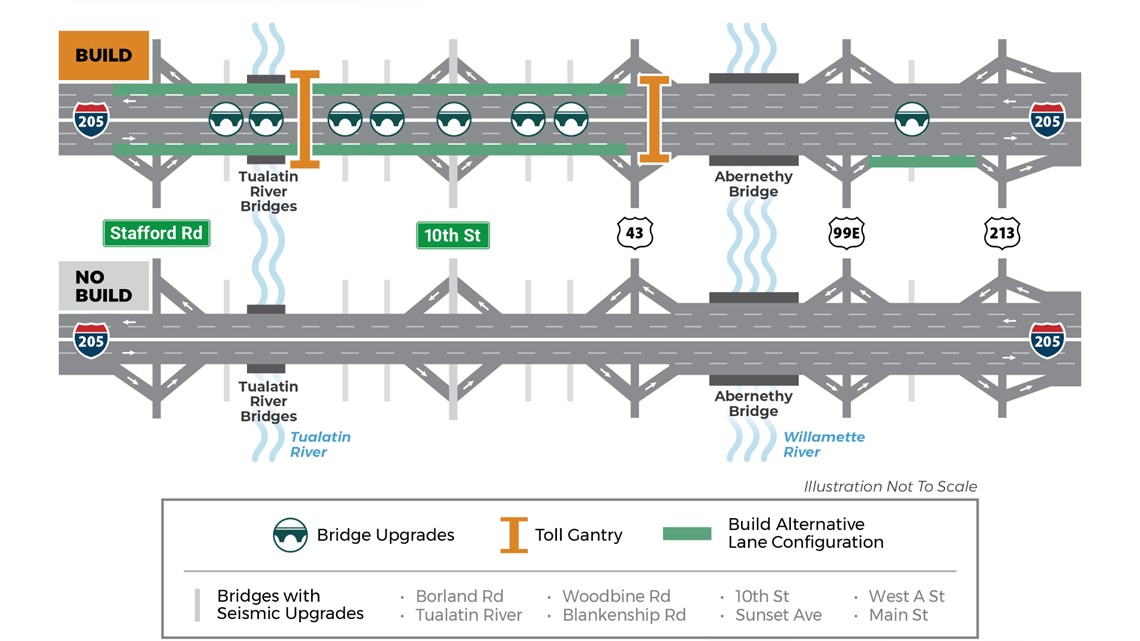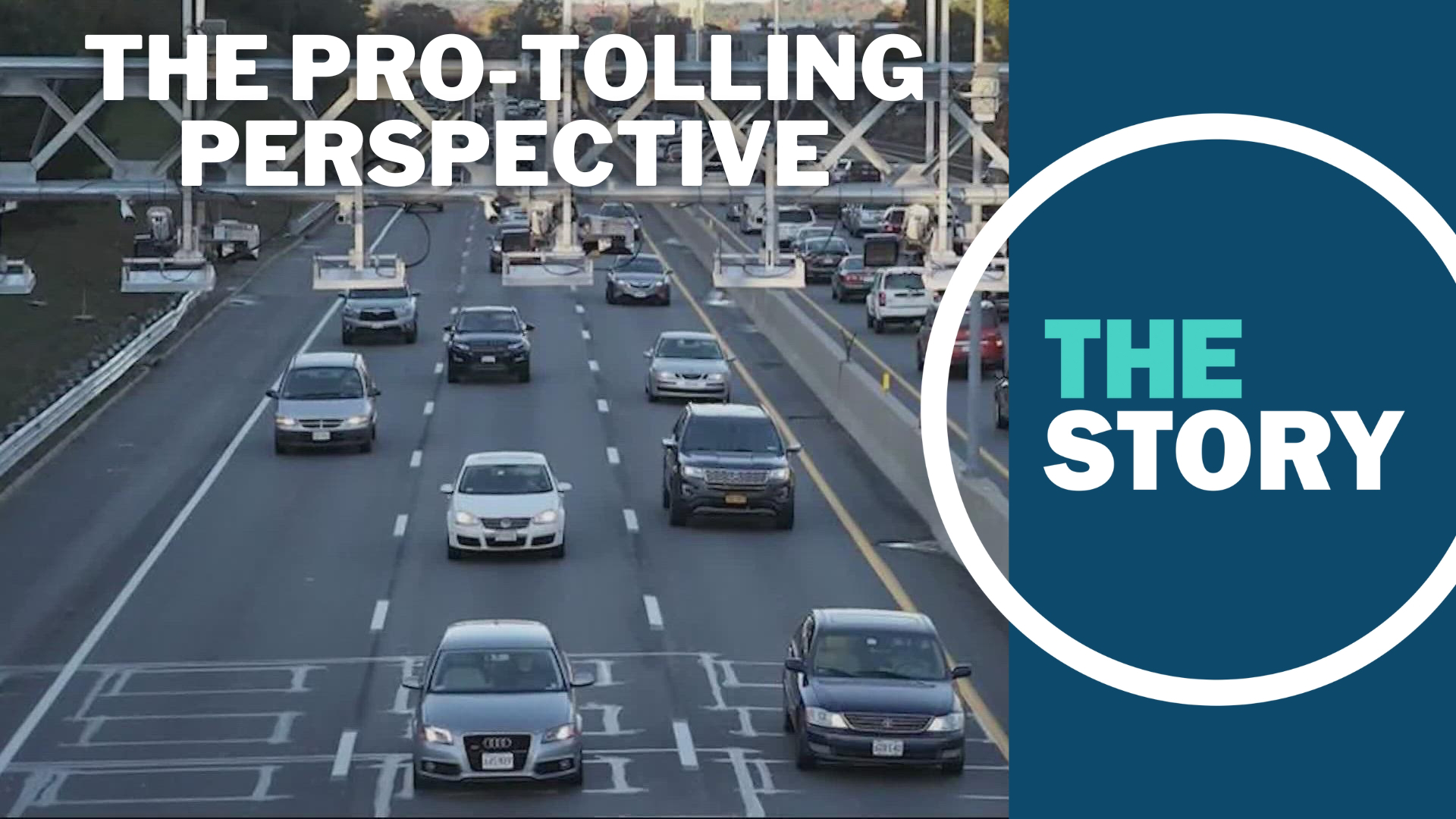PORTLAND, Ore. — Over the last several months, KGW's The Story has done multiple reports on the Oregon Department of Transportation's plans to begin tolling parts of I-5 and I-205 around the greater Portland area.
Like taxes, tolls can be an easy thing to oppose — they cost just about everybody money, even people who can ill-afford it, and the ways in which they might benefit local communities can be obscure and frankly unexciting.
As a result, many of The Story's previous stories have carried tough questions and a whole host of objections from local leaders in communities that will be impacted by the tolls. Many of the comments that viewers sent in were heavy with skepticism.
All that said, there's a reason why toll roads and bridges exist all over the United States. And Brendan Finn, director of ODOT's Urban Mobility Office, is happy to explain why they're necessary here in Oregon as well.
Finn is in charge of tolling programs for everything besides the new Interstate Bridge project, which will almost certainly come with tolls to cover the cost of construction. Finn has been working to sell Oregonians on this Portland metro program for a long time.
According to Finn, there are two main reasons for tolls — raising revenue for needed investments in the state's transportation infrastructure, and to manage the demand on some of these systems.
"It's a key component that's been used in other places around the country and seen a lot of success," he said. "I understand the unpopularity of it when it first comes out. What we really need to do to the rest of the region — and especially those impacted cities around the tolling areas — is there is gonna be a real return on investment. You are gonna see a better system, a more reliable system and a system that's safe, a system that can withstand an earthquake. Right now our system can't. We're vulnerable. So one of the things that's really important to us, when we talk about tolling … the most important thing is keeping Oregonians safe."
Finn stressed that tolling will be vital for making seismic upgrades to important bridges and other local infrastructure — upgrades that can't wait until after disaster strikes.
"I drive over the Abernethy Bridge with my family. I know that it's gonna fall if we have a major earthquake," he said. "I don't know if everybody who drives over that bridge knows that but it scares me — and I know that it's one of the more important things that we provide for those of us in public service, keeping people safe. So, again, understanding folks aren't wild about tolling … But what we really need to tell them is the benefits, and the benefits it's gonna have for generations to come."


Backing things up
For background, all signs point to tolls popping up in the Portland area in a big way. The Interstate Bridge replacement, and perhaps even the current crossing, will be tolled in order to help pay down the billions it will cost to build. That's a bit of a separate issue, however, because it's not part of ODOT's ongoing project.
The first step in the ODOT plan would see tolls added to I-205 on the Abernethy and Tualatin River bridges, on either side of West Linn. Those tolls will help pay for upgrades to the bridge, as well as adding a third lane in each direction for this section of I-205.
Eventually, additional tolls would be placed somewhere along I-205 between the Willamette River and the Columbia River.
On top of that, there will likely be tolls on I-5 in the Portland area, probably near the Rose Quarter. Those tolls would help pay for the long-anticipated widening projects there and a covered section of freeway.
The tolls were approved by Oregon lawmakers back in 2017 as part of a larger transportation bill.
And one thing that a lot of people wonder about — whatever their other merits, these tolls will not worsen traffic backups, at least not on the freeways. Gone are the days of toll booths where drivers have to stop and make their payments. Instead, tolls will be handled either through an electronic transponder issued to each driver or otherwise by snapping a picture and sending a bill to the address associated with a car's license plate, should the driver not have a transponder.
Tolls keep on tolling into the future
Right now, the tolls that ODOT has under consideration are intended to pay for specific upgrades to nearby transportation infrastructure. But that prompts a question that many people have voiced: When these projects are finished, will the tolls then go away?
Finn indicated that this isn't exactly the right way to think about it.
"No, the tolls there are meant to do two things. I guess I will say the tolls are meant to pay for — the construction will be paid through bonding. So, not to get into too much of the financial planning details, but think about your mortgage. A lot of people get a 30 year mortgage. We're getting a 30-year mortgage to pay off this bridge through the tolling program. So after 30 years, leaders at that time decide whether to keep the tolls on or take them off. That's a question for future generations."
ODOT will essentially pay for the projects in question by getting a 30-year advance through selling bonds — something the state is empowered to do, within reason — then pay those sums back, with interest, through tolling.
"We haven't decided if its 25-year or 30-year right now," Finn said. "Our financial planning team is looking at what's the best return for Oregonians."
So the tolls that ODOT is working on now may not be with us forever, but they will be around for at least 25 or 30 years. For older Oregonians, that's something like a life sentence.
Some aspects of the tolling program are still up in the air, like the cost that commuters will have to pay, or even the number of tolling spots that will eventually be on I-205 or I-5. At least for the West Linn area, prices are expected to solidify sometime next summer.
ODOT has been using a working assumption of $2 per bridge during rush hour, which would be the peak price. Under this model, costs would taper off during other hours of the day and be at their lowest overnight, but at no point would the tolls go away entirely.
Pump up the jams
Besides the cost of traversing toll points, many people who reside in nearby communities worry that drivers will ditch the interstates and pile up on surface roads to avoid having to pay — particularly when public transit isn't really an option.
The fear, then, is that tolls will reduce traffic jams on the interstate only to create more in the cities. We asked Finn about ODOT's thinking on that.
"Well, we will address the people who are bailing off by fixing that system so it flows better, by making improvements to that existing system," Finn replied. "So, at the end of the day these municipalities, these cities and towns around the metropolitan region will have an improved system."
"We kind of do it on an intersection-by-intersection basis," he continued. "And so we have a way of rating those. So we'll make sure that they stay at a certain rating so there will be a flow of traffic."


As ODOT's tolling guru, Finn said that the agency has promised to continue monitoring Oregon City and West Linn to make sure their solutions are working — and if they aren't, ODOT will find new approaches to fix the problem.
Meanwhile, the agency thinks that the whole tolling program will indeed reduce congestion on this southern part of I-205. The reasons are twofold: congestion pricing will discourage some commuters from traveling the interstate during peak hours, while the money raised from tolling allows ODOT to add in those third lanes each way.
"They compliment each other," Finn said. "So with both of them – with tolling and adding the missing third lane as we like to say on I-205 — we'll be able to take what was going to be 14 hours of congestion in 2045 and make that 2 hours of congestion. So you understand the magnitude. You really get the best use of the infrastructure that we have because we know we can't build our way out of congestion. We want to build the right system that can serve us for the next two generations. We're taking on something that we're hoping will create something that will last the next 50 years."
Finn said that they arrived at the 2-hour figure through modeling, plugging in how much traffic ODOT is seeing now compared to how much growth they anticipate.
"So the engineers sit down and crunch these numbers using the modeling that the entire region has agreed upon to say, 'Yes, this is what will happen and this is the impacts and the results of those improvements," he said.
It helps that tolling is not a new phenomenon in the U.S. There's a body of research that ODOT can look at, down to the exact cost of the tolls and what it does to congestion.
"It's only a small percentage we need to decrease to actually create a free-flowing network where our infrastructure can work the best. And it's the most efficient way to do it … about 5% is usually the rule of thumb," Finn said. "If you get 5% of those trips that are out there — and it's been said that almost 30 (percent) of those trips that are happening are discretionary. People could take those trips at another time."
Based on the data that ODOT is using, 70% of commuters during peak hours are going to work or doing something equally important like heading to a doctor's appointment — something that can't be avoided.
"That's why we really want to make sure we're not punishing those who are experiencing low incomes," Finn acknowledged.
The income issue
Theoretically, this is where taxes and tolls diverge pretty dramatically. While most taxes cost someone a certain amount based on their level of income, tolls cost the same for the poor and the rich alike. For the rich, it's a drop in the bucket. For the poor, it could be untenable.
So, Finn said, ODOT is studying the best ways to help lower-income drivers with tolls. While they've been entertaining some ideas, the concept is still evolving.
"We are the first in the nation — I do like to brag a little about this — to have considered that and plan on implementing a low-income discount or exemption program prior to actually turning on tolls," he said. "Obviously there's hundreds of tolls, tolling programs throughout the nation. None of them have actually contemplated this process prior to implementation of the toll program. So, we've heard that message loud and clear from the public, from elected leadership from around the region, and we look forward to implementing that."
Finn said that he's not able to give any more specifics on what ODOT is thinking right now. But he did say the most likely scenario is that the discount program will tap into the welfare system that currently aids low-income people, and people already in that system would automatically qualify for reduced or even free tolls.
The end product of tolling, Finn emphasized, will be something for everyone — producing a transportation system that will last Oregonians a long time.
"So it will be a benefit," he said. "People will see a benefit to the system. It will make it easier for them to get around — easier to get to their appointments, easier to get their kids to soccer games and be on time. So that's the real benefit we want to articulate to everyone."

